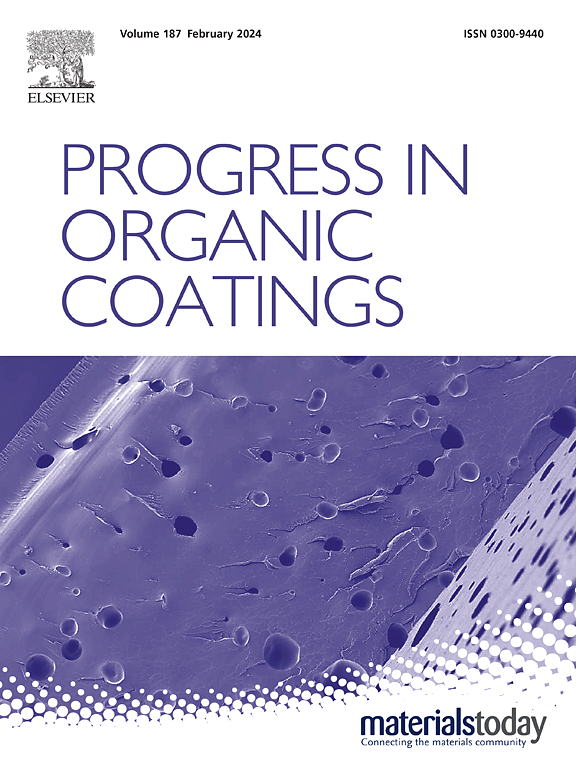自洁,防污PPS@F-SiO2/TZ涂层,具有超两疏性和抗原油附着力
IF 7.3
2区 材料科学
Q1 CHEMISTRY, APPLIED
引用次数: 0
摘要
研制一种具有超两疏性和抗原油黏附性能的涂层,对解决原油运输和储存过程中的黏附问题具有重要意义。在本实验中,制备了具有超疏水性和耐油性的涂层PPS@F-SiO2/TZA。采用多步骤改性策略构建了层状微纳米结构涂层:(1)在聚苯硫醚(PPS)颗粒上原位生长二氧化硅(SiO2)纳米颗粒,形成低表面能粗糙度;(2)反式肉桂酸修饰氧化锌(TZ)纳米填料,增强结构稳定性;(3)确保界面粘附的无机陶瓷粘结剂(ADP)。该涂层具有优异的拒液性能,与水的接触角为160°,与硅油、食用油和原油的接触角为150°。多孔表面可有效减少液固表面的接触面积,使表面和界面保持良好的Cassie状态,具有自洁性(通过滚动液滴除尘)和抗污性(抵抗泥浆和染料污染)。管道模拟测试证实了该涂层的抗粘附能力,允许油滴在倾斜/弯曲的表面上无残留地流动。这项工作为设计耐用的超双疏涂层提供了有效的策略,以减轻工业应用中的油粘附问题。本文章由计算机程序翻译,如有差异,请以英文原文为准。

Self-cleaning, antifouling PPS@F-SiO2/TZ coatings with superamphiphobicity and anti-crude-oil adhesion
The development of a coating with superamphiphobicity and anti-crude-oil adhesion is of great significance in solving the adhesion problem during the transportation and storage of crude oil. In this experiment, the coating PPS@F-SiO2/TZA was prepared with superamphiphobicity and oil adhesion resistance. The coating was constructed as a layered micro/nanostructure using a multi-step modification strategy: (1) in situ growth of silicon dioxide (SiO2) nanoparticles on polyphenylene sulfide (PPS) particles to form a low surface energy roughness; (2) trans-cinnamic acid-modified zinc oxide (TZ) nanofillers to enhance the structural stability; and (3) an inorganic ceramic binder (ADP) to ensure the interfacial adhesion. The coating has excellent liquid-repellent properties with a contact angle of >160° with water and >150° with silicone oil, edible oil and crude oil. Porous surface can effectively reduce the contact area between liquid and solid surface, so that the surface and interface maintain a good Cassie state for self-cleaning (dust removal by rolling droplets) and anti-fouling properties (resistance to mud and dye contamination). Pipeline simulation tests confirmed the coating's ability to resist adhesion, allowing oil droplets to flow without residue on sloped/curved surfaces. This work provides an effective strategy for designing durable Superamphiphobic coatings to mitigate oil adhesion problems in industrial applications.
求助全文
通过发布文献求助,成功后即可免费获取论文全文。
去求助
来源期刊

Progress in Organic Coatings
工程技术-材料科学:膜
CiteScore
11.40
自引率
15.20%
发文量
577
审稿时长
48 days
期刊介绍:
The aim of this international journal is to analyse and publicise the progress and current state of knowledge in the field of organic coatings and related materials. The Editors and the Editorial Board members will solicit both review and research papers from academic and industrial scientists who are actively engaged in research and development or, in the case of review papers, have extensive experience in the subject to be reviewed. Unsolicited manuscripts will be accepted if they meet the journal''s requirements. The journal publishes papers dealing with such subjects as:
• Chemical, physical and technological properties of organic coatings and related materials
• Problems and methods of preparation, manufacture and application of these materials
• Performance, testing and analysis.
 求助内容:
求助内容: 应助结果提醒方式:
应助结果提醒方式:


